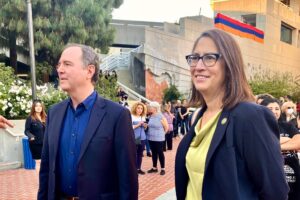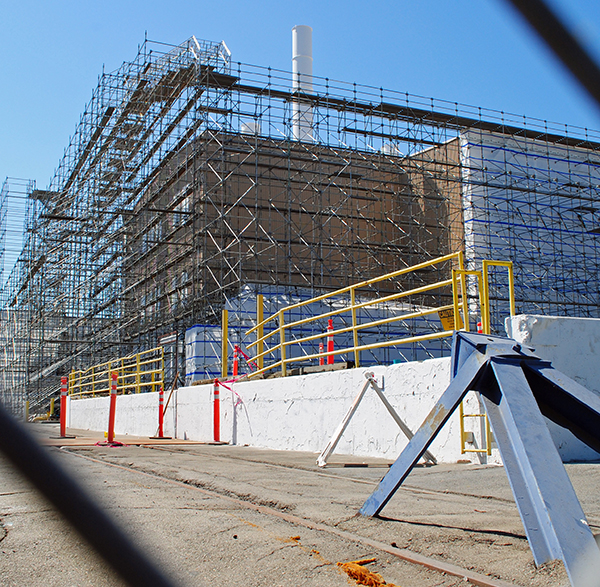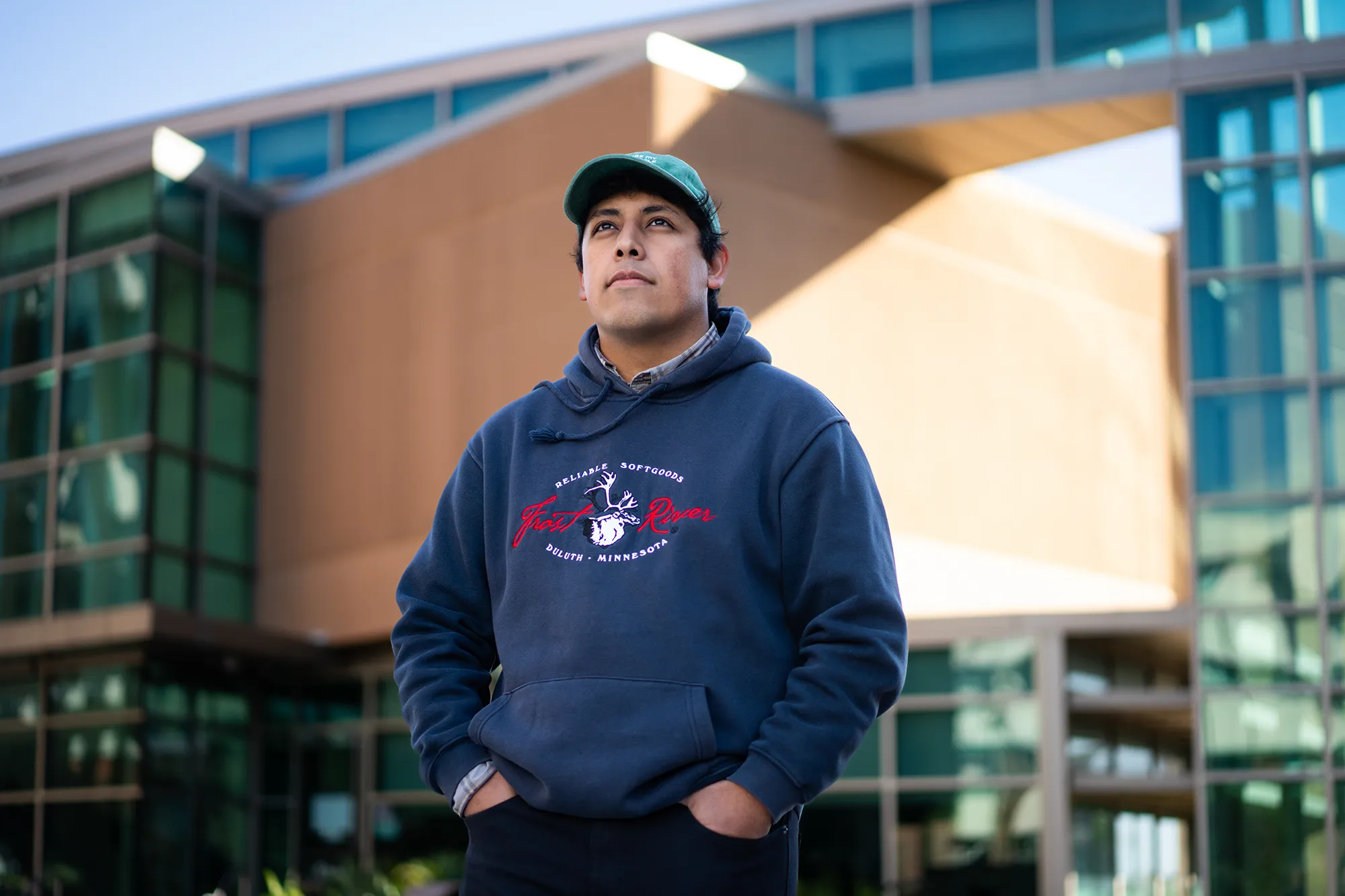By Alfredo Santana
Contributing Writer
VERNON — Lead cleaning and dismembering of the third battery recycling building at the Exide Technologies plant is nearly complete as the state Department of Toxic Substances Control prepares to take over the site on April to investigate underground pollution.
Robert Puga, a trustee of the Vernon Environmental Response Trust, said at the first 2022 online community hearing on Feb. 25 that the third of three large buildings called segments, is mostly decontaminated and deconstructed within an encapsulated structure to stop airborne lead.
“To deconstruct it, we wetted down the interior to protect pollution from escaping and for our workers’ safety,” Puga said.
He said he expects to wrap up operations within a week.
The scaffolding and special tarps covering what was the backhouse, where batteries were crushed and ripped, will be disassembled before the trust releases control of the site.
“All segments are decontaminated and deconstructed, and all their components have been decontaminated and properly deconstructed,” Puga said.
With the exception of increases recorded last May and June, air quality monitors installed on the premises revealed that readings on lead and arsenic pollutants had been low inside encapsulated segments and outdoors since the trust took over in October 2020, Puga added.
The use of water cannons and breezes to mitigate air particles has been key in that effort, although the ongoing drought in the region prompted a meeting caller to request less water use.
Jason Aspell, deputy executive officer with the South Coast Air Quality Management District, said his agency found the trust has complied with rules addressing lead and arsenic emissions.
Aspell said a recent power outage was reported in time, triggering an investigation of the incident still being conducted, and dismembering of segments 2 and 3 had been done under negative pressure.
Aside from the documented increase of airborne particles following work crews’ attempts to remove scaffolding from segment 2 as heavy winds ripped tarps open last May, “so far we have not seen any noncompliance issue,” Aspell said.
The AQMD plans to keep three onsite air monitors with one on standby and would ramp up enforcement in case are a steady rise of pollutants is measured.
A designated Title V facility must submit monitoring reports to the AQMD every six months, after the agency grants operating permits renewable every five years and until the cleanup endeavor is over.
Aspell added that random visits to residential cleanup sites had resulted in zero violations for the spread of dust or toxic emissions.
Grant Cope, deputy director of the state Department of Toxic Substances Control, announced that the agency will start a bid process for contractors willing to work in the heavily regulated project to quantify pollutants in the soil and underground of the former Exide Technologies plant.
Cope said the process would be public, bid notices will be posted on the agency’s online portal, with an April 3 deadline to select the new environmental contractor.
Future decontamination efforts at the Vernon site would be feasible thanks to a $132 million allocation from Gov. Gavin Newsom and the state legislature this fiscal year.
Formed as part of the Exide Technologies bankruptcy settlement in October 2020, the Vernon Environmental Response Trust managed $11.16 million set aside by the company to pay for efforts to clean and deconstruct hazardous structures within the plant’s perimeter where up to 11 million batteries were recycled a year.
On the residential cleanup front, the Department of Toxic Substances Control announced that homes with 200 to 300 parts of lead per million in soil within a 1.7-mile radius of the battery plant now qualify for cleanups.
The decision to include lots with lower lead levels arrives as the environmental contractor assigned to remove and replenish tainted soils at more than 1,500 units at the Wyvernwood Garden Apartments and Estrada Courts in Boyle Heights wraps up cleanings.
Department of Toxic Substances Control Assistant Director Mehdi Bettahar said that 3,390 parcels with lead in the soil have been cleaned, and only $2 million remains of the initial $251 million the state initially assigned for residential decontamination.
Of the $322.4 million Newsom allocated in fiscal year 2021-22 for parcel cleanings along with the funds for the battery recycling plant, $77.6 million are encumbered, Bettahar said.
He did not elaborate what legal criteria his department must meet to unlock those funds and help remediate about 6,600 remaining properties burdened with toxic metal plumes from the plant during its 92 years of operation.
At Wyvernwood Apartments, Bettahar said 1,176 units benefited from soil removal and replenishment, and 37 residents requested and received relocation.
For its part, 409 apartments at Estrada Courts had its front yard soil cleaned, with 15 residents relocated while the environmental mitigation took place.
“In the past, properties with the greatest amount of lead exposure were cleaned up first. All schools, parks and daycare centers had been cleaned,” Bettahar said.
Currently, 9,092 properties have been sampled, and 1,513 remain untouched due to lack of access. The state agency scheduled seven tries to reach out to owners and convince them to sign up for soil testing and eventual cleanups.
On future goals, officials project to reach and decontaminate a total of 5,940 parcels by December 2024, and pledged to maintain 30 cleanup crews.
Of those properties, Bettahar indicated that 2,089 already qualify for cleanings, and 1,253 had signed agreements to excavate and replenish soil.
From those properties, 275 parcels agreed to soil testing, and 43 had it done as of Feb. 4.
He mentioned that two sanitary landfills are used to dispose of contaminated soil. One is in Southern California and the second is in Arizona.
East Los Angeles resident Rafael Yanez said that as the rollout of cleanups block by block and the facility’s new chapter of soil testing unfold, the project’s administrators should consider applying for a Superfund designation from the Environmental Protection Agency.
“My hope is that the DTSC taps on Superfund resources to get many millions of dollars to have a proper cleanup of the site,” Yanez said.
Cope encouraged qualifying residents in Boyle Heights, East Los Angeles, Maywood, Huntington Park, Commerce and Maywood to sign up for soil testing and take advantage of current resources for lead cleanups.
“I want to echo what [has been] a tremendous amount of help on achieving the cleanups in the community. Every time you call us to address issues in the community, you help us to do a better job,” Cope said.











